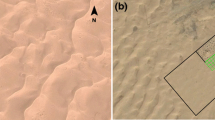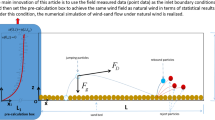Abstract
As the sand mass flux increases from zero at the leading edge of a saltating surface to the equilibrium mass flux at the critical fetch length, the wind flow is modified and then the relative contribution of aerodynamic and bombardment entrainment is changed. In the end the velocity, trajectory and mass flux profile will vary simultaneously. But how the transportation of different sand size groups varies with fetch distance is still unclear. Wind tunnel experiments were conducted to investigate the fetch effect on mass flux and its distribution with height of the total sand and each size group in transportation. The mass flux was measured at six fetch length locations (0.5, 1.2, 1.9, 2.6, 3.4 and 4.1 m) and at three free-stream wind velocities (8.8, 12.2 and 14.5 m/s). The results reveal that the total mass flux and the mass flux of each size group with height can be expressed by q=aexp(−bh), where q is the sand mass flux at height h, and a and b are regression coefficients. The coefficient b represents the relative decay rate. Both the relative decay rates of total mass flux and each size group are independent of fetch length after a quick decay over a short fetch. This is much shorter than that of mass flux. The equilibrium of the relative decay rate cannot be regarded as an equilibrium mass flux profile for aeolian sand transport. The mass fluxes of 176.0, 209.3 and 148.0 μm size groups increase more quickly than that of other size groups, which indicates strong size-selection of grains exists along the fetch length. The maximal size group in mass flux (176.0 μm) is smaller than the maximal size group of the bed grains (209.3 μm). The relative contribution of each size group to the total mass flux is not monotonically decreasing with grain size due to the lift-off of some small grains being reduced due to the protection by large grains. The results indicate that there are complex interactions among different size groups in the developmental process of aeolian sand transport and more attention should be focused on the fetch effect because it has different influences on the total mass flux, the mass flux profile and its relative decay rate.
Similar content being viewed by others
References
Arens S M, van Boxel J H, Abuodha J O Z. 2002. Changes in grain size of sand in transport over a foredune. Earth Surface Processes and Landforms, 27(11): 1163–1175.
Bauer B O, Davidson-Arnott R G D. 2003. A general framework for modeling sediment supply to coastal dunes including wind angle, beach geometry, and fetch effects. Geomorphology, 49(1–2): 89–108.
Bauer B O, Davidson-Arnott R G D, Hesp P A, et al. 2009. Aeolian sediment transport on a beach: Surface moisture, wind fetch, and mean transport. Geomorphology, 105(1–2): 106–116.
Butterfield G R. 1999. Near-bed mass flux profiles in aeolian sand transport: High-resolution measurements in a wind tunnel. Earth Surface Processes and Landforms, 24(5): 393–412.
de Vries S, Arens S M, de Schipper M A, et al. 2014. Aeolian sediment transport on a beach with a varying sediment supply. Aeolian Research, 15: 235–244.
Delgado-Fernandez I. 2010. A review of the application of the fetch effect to modelling sand supply to coastal foredunes. Aeolian Research, 2(2-3): 61–70.
Dong Z B, Liu X P, Wang H T, et al. 2003. The flux profile of a blowing sand cloud: a wind tunnel investigation. Geomorphology, 49(3–4): 219–230.
Dong Z B, Wang H T, Liu X P, et al. 2004a. The blown sand flux over a sandy surface: a wind tunnel investigation on the fetch effect. Geomorphology, 57(1–2): 117–127.
Dong Z B, Wang H T, Liu X P, et al. 2004b. A wind tunnel investigation of the influences of fetch length on the flux profile of a sand cloud blowing over a gravel surface. Earth Surface Processes and Landforms, 29(13): 1613–1626.
Dong Z B, Sun H Y, Zhao A G. 2004c. WITSEG sampler: a segmented sand sampler for wind tunnel test. Geomorphology, 59(1–4): 119–129.
Farrell E J, Sherman D J, Ellis J T, et al. 2012. Vertical distribution of grain size for wind blown sand. Aeolian Research, 7: 51–61.
Gillette D A, Herbert G, Stockton P H, et al. 1996. Causes of the fetch effect in wind erosion. Earth Surface Processes and Landforms, 21(7): 641–659.
Gillies J A, Nickling W G, King J. 2007. Shear stress partitioning in large patches of roughness in the atmospheric inertial sublayer. Boundary-Layer Meteorology, 122(2): 367–396.
Greeley R, Iversen J D. 1985. Wind as a Geological Process on Earth, Mars, Venus and Titan. New York: Cambridge University Press, 333.
Hoonhout B M, de Vries S. 2016. A process-based model for aeolian sediment transport and spatiotemporal varying sediment availability. Journal of Geophysical Research: Earth Surface, 121(8): 1555–1575.
Jensen J I, Sørensen M. 1986. Estimation of some aeolian saltation transport parameters: a re-analysis of Williams’ data. Sedimentology, 33(4): 547–558.
Kang L Q, Zou X Y, Zhao G D, et al. 2016. Wind tunnel investigation of horizontal and vertical sand fluxes of ascending and descending sand particles in aeolian sand transport. Earth Surface Processes and Landforms, 41(12): 1647–1657.
Li Z S, Feng D J, Wu S L, et al. 2008. Grain size and transport characteristics of non-uniform sand in aeolian saltation. Geomorphology, 100(3–4): 484–493.
Lynch K, Jackson D W T, Cooper J A G. 2016. The fetch effect on aeolian sediment transport on a sandy beach: a case study from Magilligan Strand, Northern Ireland. Earth Surface Processes and Landforms, 41(8): 1129–1135.
Nalpanis P, Hunt J C R, Barrett C F. 1993. Saltating particles over flat beds. Journal of Fluid Mechanics, 251: 661–685.
Namikas S L. 2003. Field measurement and numerical modelling of aeolian mass flux distributions on a sandy beach. Sedimentology, 50(2): 303–326.
Nickling W G. 1983. Grain-size characteristics of sediment transported during dust storms. Journal of Sedimentary Petrology, 55(5): 1011–1024.
Owen P R, Gillette D A, 1985. Wind tunnel constraint on saltation. In: Proceedings of the International Workshop on the Physics of Blown Sand. Aarhus: University of Aarhus, 253–269.
Rasmussen K R, Sørensen M. 2008. Vertical variation of particle speed and flux density in aeolian saltation: Measurement and modeling. Journal of Geophysical Research-Earth Surface, 113(F2): S12.
Rice M A, Willetts B B, McEwan I K. 1995. An experimental-study of multiple grain-size ejecta produced by collisions of saltating grains with a flat bed. Sedimentology, 42(4): 695–706.
Shao Y P, Raupach M R. 1992. The overshoot and equilibration of saltation. Journal of Geophysical Research: Atmospheres, 97(D18): 20559–20564.
Shao Y P, Raupach M R, Leys J F. 1996. A model for predicting aeolian sand drift and dust entrainment on scales from paddock to region. Australian Journal of Soil Research, 34(3): 309–342.
Sterk G, Raats P A C. 1996. Comparison of models describing the vertical distribution of wind-eroded sediment. Soil Science Society of America Journal, 60(6): 1914–1919.
Stout J E. 1990. Wind erosion within a simple field. Transactions of the ASAE, 33(5): 1597–1600.
Tan L H, Zhang W M, Qu J J, et al. 2014. Variation with height of aeolian mass flux density and grain size distribution over natural surface covered with coarse grains: A mobile wind tunnel study. Aeolian Research, 15: 345–352.
Tan L H, Zhang W M, Qu J J, et al. 2016. Aeolian sediment transport over gobi: Field studies atop the Mogao Grottoes, China. Aeolian Research, 21: 53–60.
van der Wal D. 1998. Effects of fetch and surface texture on aeolian sand transport on two nourished beaches. Journal of Arid Environments, 39(3): 533–547.
White B, Mounla H, 1991. An experimental study of Froude number effect on wind-tunnel saltation. Aeolian Grain Transport, 1: 145–157.
Xiao F J, Guo L J, Li D B, et al. 2012. Discrete particle simulation of mixed sand transport. Particuology, 10(2): 221–228.
Xiao F J, Guo L J, Li D B, et al. 2013. Modeling the evolution of aeolian sand transport in a wind tunnel. AIP Conference Proceedings, 1547(758). doi: https://doi.org/10.1063/1.4816930.
Xing M. 2007. The harmonious character in equilibrium aeolian transport on mixed sand bed. Geomorphology, 86(3–4): 230–242.
Yang Y Y, Liu L Y, Li X Y, et al. 2019. Aerodynamic grain-size distribution of blown sand. Sedimentology, 66(2): 590–603.
Acknowledgements
This research was supported by the National Natural Science Foundation of China (41601002, 41871011), the China Postdoctoral Science Foundation (2017M623115), the Science Foundation of Shaanxi Province (2018JQ4010) and the Fundamental Research Funds for the Central Universities (GK201903077). The paper was written while the corresponding author held a visiting position in the BEADS Lab at Flinders University, Australia. Thanks to Professor Patrick HESP and the BEADS Lab for support.
Author information
Authors and Affiliations
Corresponding author
Rights and permissions
About this article
Cite this article
Chen, Z., Xiao, F. & Dong, Z. Fetch effect on the developmental process of aeolian sand transport in a wind tunnel. J. Arid Land 12, 436–446 (2020). https://doi.org/10.1007/s40333-020-0102-x
Received:
Revised:
Accepted:
Published:
Issue Date:
DOI: https://doi.org/10.1007/s40333-020-0102-x




